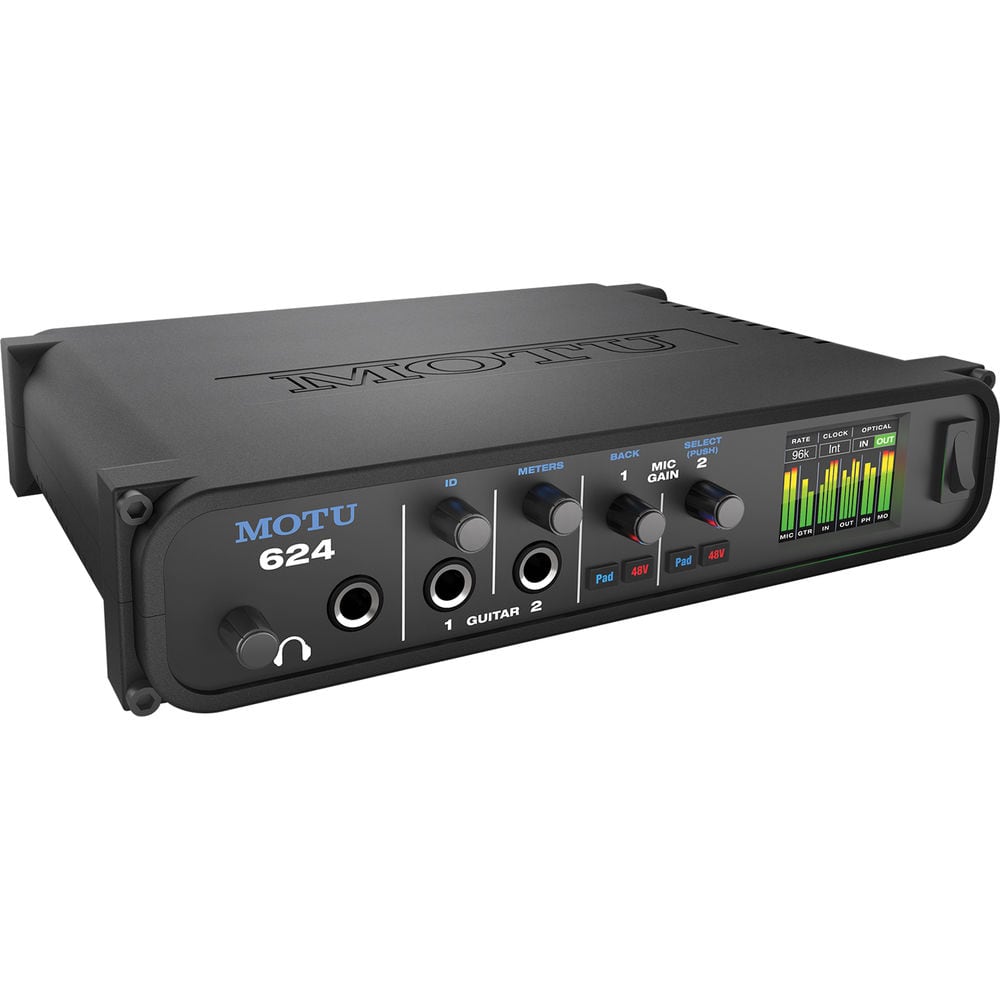MOTU 624
The MOTU 624 is a premium 24×26 USB 3.0/ Thunderbolt Audio Interface with AVB Networking and DSP. The 624 is designed for studio recording, installed sound, and live sound-reinforcement applications such as mixing a small band in a club or music venue. The device features two balanced microphone inputs with individually switchable +48V phantom power, and two dedicated hi-Z guitar inputs. Additionally, there are four ¼” line inputs, four ¼” line outputs, and a pair of “Main” ¼” outputs. A single set of ADAT optical ports provides an additional 8 inputs and outputs for a total of 16 inputs and 16 outputs. Expansion I/O can be added to the system through AVB networking.
The MOTU 624 interface utilizes ESS Sabre32 Ultra converters to provide a dynamic range of 123 dB while recording at up to 24-bit/192 kHz resolution. Using Thunderbolt connectivity, the audio interface can stream 64 audio channels in and 64 channels out to the interface’s physical outputs, the DSP-powered 48 digital routing matrix, or AVB audio network streams. The interface can also use high-speed USB 3.0 using class-compliant drivers to work with most digital audio workstations.
The 48-channel digital mixer can mix physical inputs on the interface, audio channels from your host computer software, AVB audio network streams, or mixer outputs. It features seven stereo auxiliary busses, three groups, a reverb buss that can serve as an alternate 4th group, a main mix buss, and a separate monitor buss that can function as a solo buss.
The mixer includes 32-bit floating-point precision DSP-powered models of three British analog console EQ profiles, a classic compressor module with optional peak/RMS operation, and a model of the legendary Teletronix LA-2A optical leveling amplifier with automatic gain control (AGC) characteristics. Each input channel strip features a high-pass filter, a gate, a four-band parametric EQ, and a compressor.
The first of its kind, this interface features an AVB Ethernet port that adopts the AVB industry networking standard for transporting high-bandwidth, low-latency audio and video over Ethernet. It was developed by the IEEE and enables connection to a second MOTU AVB audio interface (1248, 8M, or 16A) via a CAT-5E or CAT-6 Ethernet cable. The standard is open, meaning it is not proprietary, and will allow for interoperability across different devices and brands.
The system can be further expanded through connection to an optional MOTU AVB Switch, for five total devices, giving it the capacity to stream over 512 channels on the network. Sixteen 8-channel network streams may be broadcast while simultaneously listening to sixteen 8-channel network streams. The AVB network provides its own network-wide time base for phase locking all connected devices, and also allows one of the connected devices to be assigned as the master clock. An added benefit of the AVB network standard is the automatic device discovery for self-configuration, 100-meter cable runs, as well as the system’s Stream Reservation Protocol, which provides guaranteed Quality of Service (QoS) and an uninterrupted point-to-point network connection.
The audio interface’s on-board DSP, mixing, device settings, and network-audio routing can all be controlled through a web application running on a web browser from a laptop, tablet, or smartphone connected by wire or Wi-Fi to your local area network. This allows the interface to be controlled using Mac, Windows, Linux, iOS, and Android devices, provided they share the same network. By connecting an Apple Airport or other Wi-Fi router directly to the interface with a standard Ethernet cable, the mixing and DSP controls of the interface can be managed using a Smartphone or tablet, without the need for a computer.








